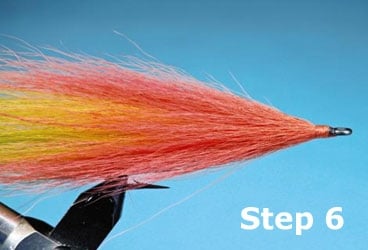[Click through all the images below to see how to tie the Bucktail Deceiver.]
I began fly-fishing in 1947 and have fished many waters around the planet. As you might imagine, I have seen and fished a lot of fly patterns — some good, some bad and a few that were outstanding.
I have watched fly tiers around the globe, and I believe that Bob Popovics is the most innovative ever. Most tiers take conventional materials and create new patterns, but Popovics uses all sorts of materials and develops new concepts to produce a variety of flies that catch fish. Best of all, almost all of his patterns are easy to learn and quick to tie. I have said for years that if a fly takes more than seven or eight minutes to complete, I won’t tie it.
Popovics once sent me a fly he had just developed. At first glance I wasn’t impressed, but when I tied a few and watched them in the water, I really became intrigued. Having now used this fly in fresh and salt water throughout the United States, Canada, Nicaragua and Cuba, I think that this may be one of the best patterns he has ever created. Certainly it is the most effective new streamer fly I have fished. Popovics calls his fly the Bucktail Deceiver, or BTD.
The most important quality of any good pattern is that it appeals to fish — and this one has proven itself on numerous species. Further, a good fly should be simple to tie, and the BTD is especially easy, even for novices. The best patterns also cast smoothly and don’t foul. I’ve made thousands of casts with this fly, and it fouled less than a dozen times. Of course, a great fly should be constructed from materials that are easily obtained and relatively inexpensive, and few materials are more readily available than buck tail. In the water, an effective fly needs to “swim” realistically and have a nice shape when retrieved, and I have seen few flies that have a subtler and more seductive action than the BTD. In addition, you can tie this fly in almost any length, with or without weight. The Bucktail Deceiver has many other incredible attributes, but I think you can already see it has a lot to offer.
To tie it you need only a bucktail, some flash and a hook for flies longer than 3 1/2 inches I prefer to use a long shank hook. If you want to fish the fly just below the surface or you want it to suspend in the water, I suggest using a thinner hook. To fish deeper in the water column, use a heavier-gauge hook. If you dress the pattern sparsely, it resembles a sand lance or other sleek baitfish, and it sinks fairly fast.
But when you place a liberal amount of bucktail on the fly, it sinks so slowly it appears suspended when you stop retrieving it. You can also fish it in very skinny water without snagging if you dress it heavily. Since it’s made solely from bucktail, the fly falls to the water almost like a parachute when cast, so you can drop it right in front of fish and not spook them. This method has served me well on laid-up tarpon and snook.
I rarely get excited about a fly pattern, but I can tell you I’m tying a number of BTDs in different sizes and color combinations (I really like an all-white wing and body with a chartreuse collar) for future trips. I urge you to try Popovics’ Bucktail Deceiver — you won’t be disappointed.
MATERIALS
- Body: Bucktail (very long if possible) in contrasting colors. Lighter colors should be the longest, while the darkest color, used for the collar, should be moderate to short.
- Flash: Flashabou in complementary colors
- Glue: Head cement
- Thread: Flat waxed-nylon or mono thread
- Eyes: Mylar stick-on (optional)
- Hook: Tiemco 911s or similar long shank hook
Bob Popvics’ Bulkhead Deceiver Tying and Fishing Tips
Let it breathe! Take your time on the retrieve and allow the water to flow in and out of the bucktail tips. Because it’s made entirely from bucktail, it has an action that many of today’s patterns don’t. If you are using a quicker retrieve, the BTD’s rear portion moves like a fish’s tail as the fly swims through the water. You can also put a Banger head on the front to create some serious surface action. Tying the fly with an extended mono body will appeal to offshore and surf or jetty fly-fishermen. Just begin tying the fly on a piece of mono stretched between two vises, then attach the mono to the shank of the hook just above the bend and continue tying. I have created BTDs over a foot long using this method.
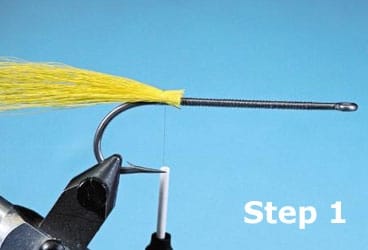
Tying the Bucktail Deceiver
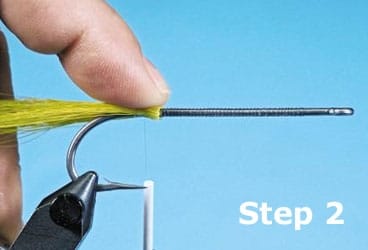
Tying the Bucktail Deceiver
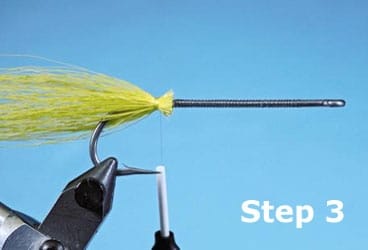
Tying the Bucktail Deceiver
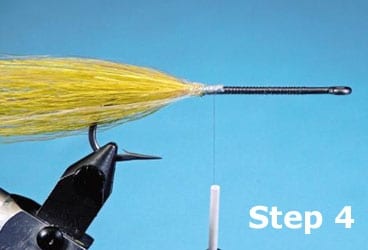
Tying the Bucktail Deceiver
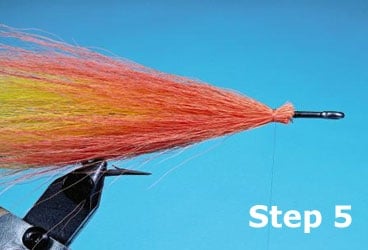
Tying the Bucktail Deceiver
